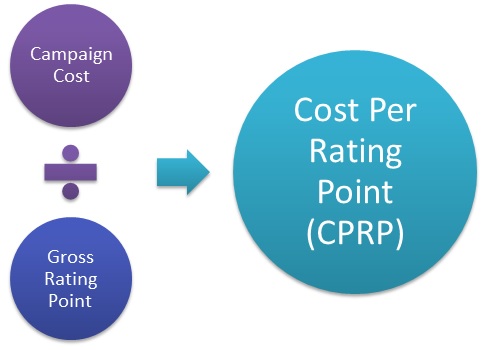- Business Concepts ›
- Marketing and Strategy ›
- Cost Per Rating Point (CPRP)
Cost Per Rating Point (CPRP)
Definition, Importance & Example
This article covers meaning & overview of Cost Per Rating Point (CPRP) from marketing perspective.
What is meant by Cost Per Rating Point (CPRP)?
The cost of reaching 1% of the targeted audience in print (advertisements) or any other media vehicle is called cost per rating point (CPRP or CPP). In other words, it refers to the cost of buying one percent of the target population.
Formula for Cost Per Rating Point (CPRP)
CPRP = Cost of the Campaign / Gross Rating Points
CPP is also referred as cost per gross rating point.
CPRP tells you the amount required to be spent in order to reach the desired target audience on various media platforms i.e. CPP lets you to plan your media budget efficiently. CPP also lets you to compare the costs and the efficiency of different outlets. It also serves as a permanent record of the advertising expenses.
The greatest problem with CPP is that it does not ensure that different people will be reached at a particular time or just a single person will be reached repeatedly many times. CPP by itself does not provide any analysis. It is primary for budgeting purpose.

Importance of Cost Per Rating Point
Cost Per Rating Point is abbreviated s CPRP or CPP. Cost Per Rating Point is one of the media and advertising planning terminologies which is an essential measure of the cost incurred by the company through a particular advertisement. The term CPRP holds intrinsic depth which needs to be understood by marketers to be able to find relevance and for the success of the marketing campaign. Media planning ideally requires assessing cost that is incurred to reach one customer in the target group. CPRP is an important framework used which calculates the cost borne by the company to reach/or pass on the message to one individual in the target group. But because it is impossible to find the reach of the ad through exact number of individuals, media planners resort to consider the rating point to get an average measure. It is evaluated as the ratio between campaign cost and gross rating point (GRP). It is used as one of their planning tools by the media planners for:
• Implementation
• Barriers to Accuracy
• Boost Your Career
• Blind Spots
Example of Cost Per Rating Point
|
VIEWER |
START TIME |
STOP TIME |
TOTAL TIME VIEWED |
|
A |
9.3 |
9.35 |
5 min |
|
B |
9.39 |
9.49 |
10 min |
|
C |
9.35 |
9.55 |
20 min |
|
D |
9.5 |
10 |
10 min |
|
E,F,G,H,I,J |
Did Not Watch |
Total Duration of the program= 30 min
Total Respondents
TRP= (((5+10+20+10)/30)/10)*100 = 15TVR
The sum of all TRP’s is the GRP or the Gross Rating Point which is only a relative number.
CPRP is the cost to achieve one rating point.
Similarity between CPRP and CPT
Much like the CPRP, there is another concept which also measures the effectiveness of the programs or advertisements but is more globally accepted. It is the CPT or Cost Per thousand. It is a metric which calculates the cost incurred by the company to reach one thousand customers or households through the advertisement. The recent debates in TV buying prefers the use of CPT because CPT does not account for the stickiness or the viewing time by the audience. Cost Per Rating Point has anomaly because it considers the time. So even if the audience base and reach is growing, it may show a reduced rating point because of the stickiness factor. It becomes easier for broadcasters to increase prices as well.
CPT = Cost * 1000/ Target Audience
But both CPRP and CPT are important metrics to quantify the effectiveness of the advertisement and for media planners to adjust their cost.
Hence, this concludes the definition of Cost Per Rating Point (CPRP) along with its overview.
This article has been researched & authored by the Business Concepts Team which comprises of MBA students, management professionals, and industry experts. It has been reviewed & published by the MBA Skool Team. The content on MBA Skool has been created for educational & academic purpose only.
Browse the definition and meaning of more similar terms. The Management Dictionary covers over 1800 business concepts from 5 categories.
Continue Reading:
What is MBA Skool?About Us
MBA Skool is a Knowledge Resource for Management Students, Aspirants & Professionals.
Business Courses
Quizzes & Skills
Quizzes test your expertise in business and Skill tests evaluate your management traits
Related Content
All Business Sections
Write for Us